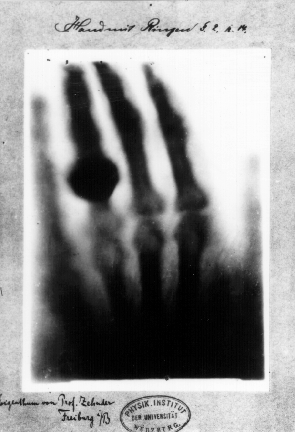Difference between revisions of "Radioactivity"
| Line 25: | Line 25: | ||
#Types of Radioactivity | #Types of Radioactivity | ||
#Uses of Radioisotopes | #Uses of Radioisotopes | ||
| + | #To learn about Gamma Deacy,Alpha Decay,Beta Decay and X-rays. | ||
===Notes for teachers=== | ===Notes for teachers=== | ||
Revision as of 13:36, 9 June 2014
X-rays are part of the electomagnetic spectrum. They were discovered by Roentgen.
Please click here for more information.
The following is a picture from the first medical X-ray.
 Source: Wikipedia
Source: Wikipedia
Usage
Create a new page and type {{subst:Content}} to use this template
Concept Map
Textbook
To add textbook links, please follow these instructions to: (Click to create the subpage)
Teaching Outlines
Concept #
Learning objectives
- Radioactivity and Half Life Definition
- Types of Radioactivity
- Uses of Radioisotopes
- To learn about Gamma Deacy,Alpha Decay,Beta Decay and X-rays.
Notes for teachers
These are short notes that the teacher wants to share about the concept, any locally relevant information, specific instructions on what kind of methodology used and common misconceptions/mistakes.
Activity No #
- Materials/ Resources needed
- Prerequisites/Instructions, if any
- Multimedia resources
It should be informative, interesting and less than 7 minutes-- Created using PowToon
Source:Youtube
- Website interactives
Interactive Simulations of Alpha Decay
Alpha decay
Source:PHET
Interactive Simulations of Beta Decay
Beta Decay
Source:PHET
- Evaluation
As students read about these scientists, ask them to think about the following questions:
What important discovery was made by Wilhelm Roentgen?
What material did Antoine Becquerel work with in his own investigations of X rays?
What did Becquerel discover through his experiments?
What two elements were discovered by Marie and Pierre Curie?
Why is Ernest Rutherford considered the father of nuclear physics? List Rutherford's major achievements.
Project Ideas
answer the following question before going to topic